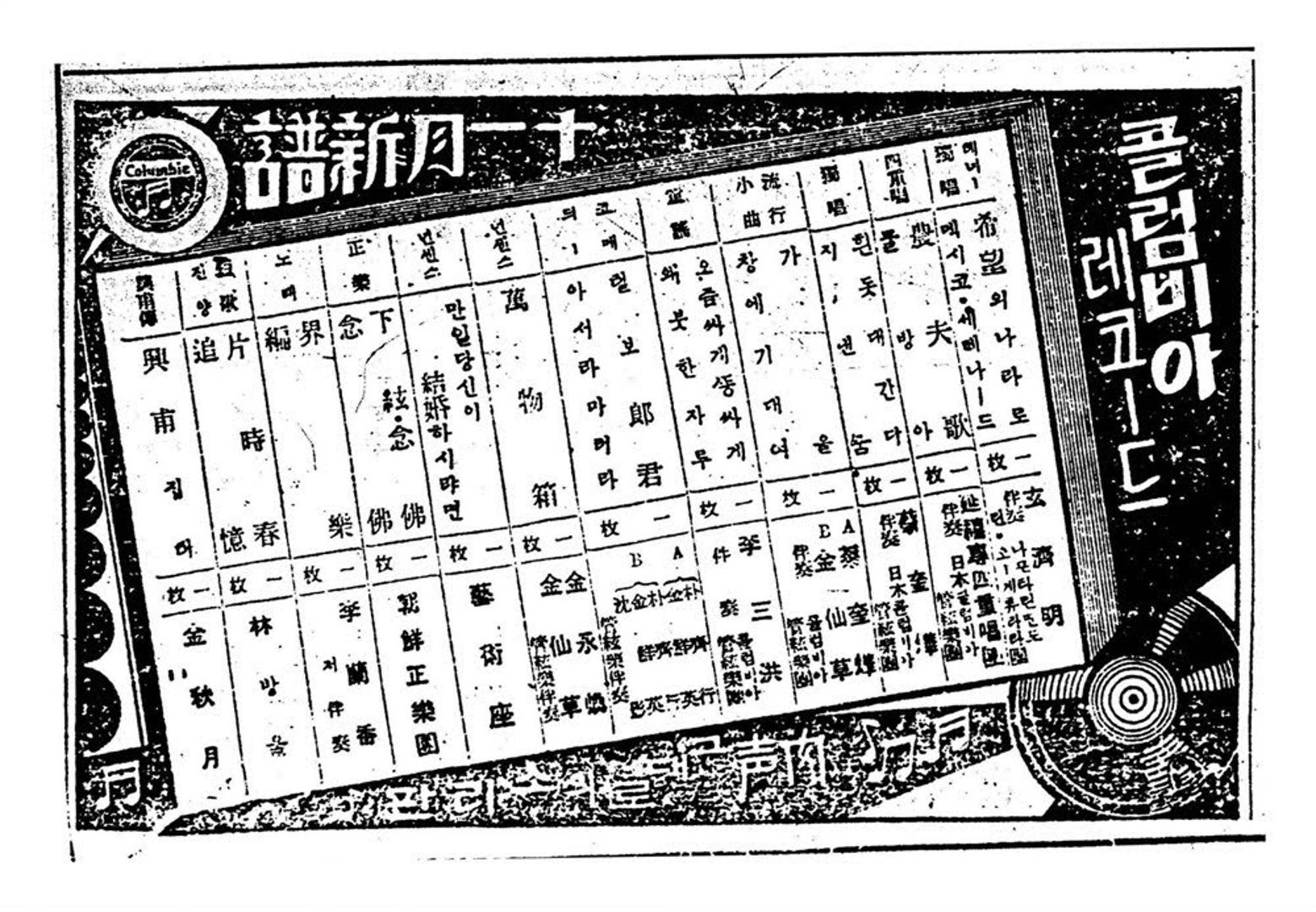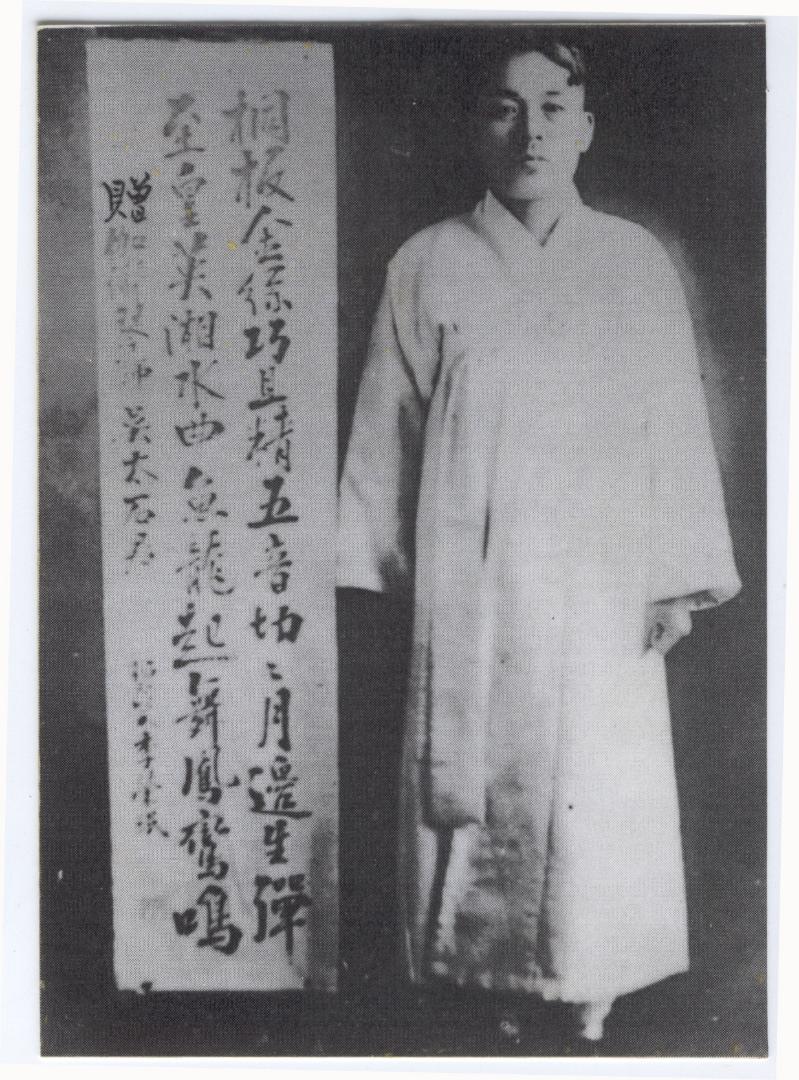 (5)(1)_thumb03.jpg)
100년 전 소리의 기록
100여 년 전 유성기 음반에 녹음되어 현재까지 전해지고 있는 우리 소리를 들어보세요 A record of sound in a century ago Listen to the Korean Musics Recorded on Gramophone 100 Years Ago
_thumb03.jpg)
조선에 들어온 유성기
1888년 에디슨의 원통형 유성기 발표이후, 조선에도 유성기가 들어왔습니다. 1896년 미국에서는 조선인 유학생들이 부른 민요와 잡가 등을 녹음해 취입했고, 1899년에는 서울 삼청동 감은정에서 조정 관리들이 유성기를 통해 춘향가와 가사, 잡가 등을 녹음했습니다. The phonograph player landed in Joseon After Edison's announcement of the Perfected Phonograph in 1888, the machine was introduced to Korea. It was first imported to Korea in 1896 when Korean folk songs sung by Korean students in the US were recorded using cylinder phonographs. In 1899, Korean government officials in charge recorded the Korean vocal music using the phonograph at Gamunjeong Pavilion in Samcheong-dong, Seoul.
(0)_thumb03.jpg)
전기 녹음 기록의 시작
1920년대 전기녹음을 시작으로 많은 음반회사가 설립되면서 유성기 음반 시장은 전성기를 맞이합니다. 조선에서 전기 녹음을 처음 시작한 것은 일본 빅터 레코드 회사로 1928년에는 국립국악원의 전신인 이왕직아악부와 계약을 맺고 조선궁중음악을 녹음했습니다. The Beginning of Electrical record With the establishment of many recording companies, the phonograph market has reached its peak after the introduction of electrical recording technology in 1927. It was the Victor company who adopted the technology for the first time in Korean peninsula. Victor published a 40-side-volume of record in 1928 under the co-work license with the Music institute of Royal Yi family, which is the former institute of the National Gugak Center.
 (5)_thumb03.jpg)
궁중음악의 기록
빅터 레코드에서 1928년에 발매한 "조선아악"은 전기녹음 방식을 사용하여 마이크로폰으로 녹음한 궁중음악 최초의 음원 기록입니다. 조선 궁중의 제례악과 연례악이 녹음된 "조선아악"은 총 26곡을 수록했고, 최고 품질 음반인 적반(붉은색 라벨)으로 발매되었습니다. The record of Royal court music The "Joseon Aak" series, published in 1928, has the earliest title of Royal court music record in history through the electrical recording technology, so-called as a microphone. The album has 26 tracks including ancestral shrine music and banquet music of Joseon dynasty. All discs were red-labeled, which shows the highest quality of sound.
_thumb03.jpg)
빅터, 조선아악, 서일화지곡(해령)(1928)
"조선아악" 음반에 담긴 '서일화지곡(해령)'은 "여민락령(본령)"의 일부 선율을 변주한 음악입니다. 연주는 아악부원양성소 1,2기 졸업생과 함화진이 참여했습니다. 이 곡은 1943년 발매된 "아악정수" 앨범에도 재수록 되었습니다. Victor, Joseon Aak Seoilhwa Jigok(Haeryeong)(1928) 'Seoilhwajigok (Haeryeong)'in the "Joseon Aak" album is a music that variates some of the melodies of "Yeominrakryeong (Bonyeong)." The performance was attended by the first and second graduates of the Aakbuwon Training Center and Ham Hwa-jin. The song was also featured on the album "The essence of Aak" released in 1943.
_thumb03.jpg)
궁중음악에서 대중음악으로
1928년 빅터의 "조선아악" 취입 이후, 조선의 궁중음악은 라디오 방송과 공연을 통해 대중에게 소개되었고, 궁중음악에서 대중음악으로 확장되는 계기가 되었습니다. 당시 제작된 아악부 정간보 11종과 오선보 200점은 현재 국립국악원을 통해 보존되고 있습니다. Royal court music to popular music After Victor published the "Joseon Aak" series in 1928, Joseon's royal court music was introduced to the public through radio broadcasts and stage performances, and it became an opportunity to expand from court music to popular music. Those transcripts produced at the time, including 11 pieces of old transcripts and 200 pieces of five-staff-note transcripts, are now preserved at the National Gugak Center.

빅터 조선아악정수(1943)
빅터는 1943년에 "조선아악" 26곡 중 12곡을 선별하여 "조선아악정수" 6장으로 재발매 합니다. 이 앨범은 당시 제5대 아악사장이었던 함화진이 저술한 음반 해설책인 "조선음악소고"를 포함했습니다. Victor’s The essence of Aak series(1943) 12 out of 26 tracks were selected from the "Joseon Aak"(1928) series, and republished as a new series entitled "The essence of Aak" in 1943. The new series is composed of 6 discs with a commentary book called “Short articles on Joseon music,” which deals with Korean music written by Ham Hwajin, the 5th Dean of the Music Institute of Royal Yi family.
 조선음악소고_thumb03.jpg)
궁중음악의 해설서
"조선음악소고"는 유성기음반 "조선아악정수"의 해설서 입니다. 특별히 이 책은 광복 이후 국립국악원 전통음악 계승에 있어 큰 역할을 하여, 당시의 궁중음악을 보존 전승할 수 있는 자료가 되었습니다. The listening guide of Royal court music “Short articles on Joseon music,” enclosed in the "The essence of Aak' album is a listening guide of Royal court music. Particularly, this booklet played an important role to maintain the tradition handed down to the National Gugak Center. Also, it became one of the crucial material to retore Joseon’s Royal court music, which had been destroyed through Japanese colonial period and Korean War.

풍류음악의 기록
빅터의 "조선아악"이 조선 궁중음악을 기록하고 있다면, 1930년대 조선정악단이 녹음한 콜롬비아 음반은 조선 풍류음악인 "영산회상"을 기록하고 있습니다. "영산회상"은 조선시대부터 지금까지 가장 많이 연주되는 기악곡으로, 연주곡 뿐 아니라 무용반주 등의 반주곡으로도 활용되고 있습니다. The record of indoor ensemble music, Pungnyu Victor's "Joseon Aak" series well keeps Joseon’s Royal court music. While, Columbia released 1930s’ indoor ensemble music, called Pungnyu or Yeongsanhoisang, played by Joseon Jeongakdan group. Yeongsanhoisang is one of the most played instrumental music since Joseon period not only as an ensemble, but also as a dance accompaniment.

조선정악단의 영산회상
콜롬비아에서 발매된 조선정악단의 "영산회상" 음반은 "영산회상" 총 13곡 중 11곡이 녹음되어 있습니다. 조선 풍류음악이 녹음된 "영산회상"은 일제강점기, 급변하는 사회 속에 계급이 사라지며 수요층을 잃은 조선시대 문인들의 음악을 현재까지 보존 전승시켜주는 소중한 음악 기록 유산입니다. Yeongsanhoisang played by Joseon Jeongakdan group There are 11 tracks recorded in the Columbia’s series out of 13 whole pieces of Yeongsanhoisang music. This ensemble series is a precious musical legacy that bonds between the past and present within the music of aristocrats, who had lost its demand by revolutionary shift through colonization and social hierarchy in modern history of Korea.
 영산회상 중 A. 타령 (조선정악단)(2)_thumb03.jpg)
콜롬비아 영산회상(1930)
콜롬비아 음반의 "영산회상"은 1930년 9월부터 1932년 11월까지 총 7장의 음반을 발매했습니다. "영산회상" 음반 발매 순서는 일본 순회공연 시 청중들의 반응과도 관련이 있다고 합니다. 그 중 가장 먼저 발매한 '타령' 과 '군악' 은 조선합주곡 중 최고라는 높은 평가를 받았습니다. Columbia’s Yeongsanhoisang(1930) Columbia’s "Yeongsanhoisang" series had been released from September 1930 to November 1932. With a total of 7 discs, the order of release is said to be related to the reaction of audience while the musicians’ tour concert in Japan. Of the first release, “Taryeong” and “Gunak” were highly regarded as the best.
_thumb03.jpg)
현재까지 보존 전승되고 있는 조선의 풍류음악 '영산회상' 중 '타령'을 국립국악원 연주로 감상해 보세요. Please enjoy “Taryeong” presented by the National Gugak Center. “Taryeong” is one of the whole Yeongsanhoisang pieces that has been well preserved up to present.

민속음악의 기록
1930년대 이후 유성기 음반의 대량 제작과 대중적 판매가 이루어지면서 판소리, 잡가, 기악독주곡 등의 민속음악도 많은 사랑을 받게 됩니다. The records of folk music By the successful growth of phonograph record business after 1930s, a mass-production and mass-sales system were made. Those folk music genres of pansori, japga, and instrumental music were welcomed by people as well.
 B. 대금독주(박종기)_thumb03.jpg)
콜롬비아 대금독주(1929)
콜롬비아 레코드에서 1929년 발매한 "대금독주" 음반은 A면에는 대금산조 중 '중모리'가, B면에는 "춘향가" 중 '군노사령 나가는데' 가 대금독주로 녹음된 음반 입니다. 대금은 박종기 명인이, 장구는 백점봉 명인이 연주했습니다. Daegeum solo by Columbia(1929) A <Daegeum solo> album was released in 1929 by Columbia. Daegeum was played by master Bak Jonggi with Baek Jeombong’s Janggo accompaniment. A part of Daegeum sanjo (Jungmori section) was recorded on side A, and a pansori Chunhyangga’s scene where the military commander steps out played by Daegeum solo on side B.

대금독주곡 중 '원장현류 대금산조'를 진양조-중모리-중중모리-자진모리 장단의 변화를 느끼며 감상해보세요. You may listen to the full version of Daegeum sanjo composed by Won Janghyeon in the orders of tempo: Jinyangjo – Jungmori – Jungjungmori – Jajinmori. Please try to notice the change of tempi.
 가야금병창 춘향가 중(오태석)_thumb03.jpg)
가야금 병창의 인기스타 심상건과 오태석
가야금 병창은 판소리를 가야금 연주와 함께 노래하는 장르입니다. 유성기 음반에 담긴 소리 중 가장 인기 많던 스타는 심상건과 오태석을 손꼽을 수 있습니다. Sim Sanggeon and Oh Taeseok, the big stars of Gayageum Byeongchang Gayageum Byeongchang is a style that one man sings a pansori styled melody with the gayageum play at the same time. Sim Sanggeon and Oh Taeseok were the best of the most popular gramophone stars.
_thumb03.jpg)
부드럽고 우아한 심상건의 소리
심상건은 가야금병창을 집대성한 인물이자 가야금산조의 명인입니다. 그의 소리는 경기/충청지역의 판소리를 바탕으로 한 부드럽고 우아한 서정적인 소리로 평가됩니다. 1926년 제비표 레코드에서 가야금산조 전바탕과 함께 가야금병창 곡을 취입하였는데, 현재 이 음반은 희귀본으로 전하고 있습니다. Sim Sanggeon, with soft and elegant voice Sim Sanggeon is one of the best gayageum players who composed his own set of sanjo music. He also compiled many different gayageum byeongchang repertoires. His melody is considered as the typical style of Gyeonggido and Chungcheongdo area, where is the south of Seoul distinguished by soft and elegant voice. In 1926, whole pieces of sanjo music and gayageum byeongchang repertoires were recorded and released by Nitto record company. These discs became rare items since only few discs have been found so far.

씩씩하고 극적인 오태석의 소리
오태석의 경우 어린 시절 명고수로 알려진 아버지 오수관과 박덕기에게 가야금을 배웠고, 판소리 동편제의 대가 송만갑에게 판소리를 배워, 가야금병창 분야에 음악기록유산을 남겼습니다. 남도 판소리를 바탕으로 한 그의 소리는 드라마틱한 창법과 화려하고 박진감 넘치는 가야금반주로 많은 사랑을 받았습니다. Oh Taeseok, with gallant and dramatic voice Thanks to his father Oh Sugwan, a famous drummer, Oh Taeseok was widely exposed to musical environment than anyone else in town. He learned gayageum from Bak Deokki, and pansori from Song Mangap. All of his teachers were great masters of music. Finally, he left a legendary heritage in the field of gayageum byeongchang. Oh Taeseok was beloved by audience since his melody employs gallant and dramatic voice and technique.
_노래하는가야금놀다가_프로필사진 (2)(0)_thumb03.jpg)
100년 전 소리의 활용
유성기 음반을 통해 기록된 우리 소리 국악은 100년 후인 지금까지 보존 전승되어 과거와 현재, 그리고 미래를 이어가는 음악으로 기록되고 있습니다. 현재의 기록 매체인 영상을 통해 국립국악원 "Gugak in" 공연에 담긴 '심봉사, 심청이를 보다'를 가야금 놀다가 팀의 병창 연주로 감상해보세요. The sound of a century ago, and its use Korean music, recorded on gramophones are holding the past, and will bond more than a century up to present days and beyond. National Gugak Center launched a music video filming support for Korean music contents, titled <Gugak in>, under COVID-19 pandemic period. One of the selected team was ‘Play Gayageum Noldaga’, and their video is titled “Simbongsa sees Simcheong. Please watch their video clip through contemporary technology: the on-line video format.
에필로그
<인기있던 사랑노래 '춘향가'>를 통해 유성기 음반에 담긴 창극 "춘향전"에 대해서도 알아보세요. 국악아카이브-소장자료 검색 코너에서 더 많은 유성기 음반을 감상하실 수 있습니다. Explore more of gramophone record collections on the website of Gugak Archive 제작: 국립국악원 국악연구실 총괄: 김영운 기획총괄: 김명석 기획: 김소리 기획진행 / 운영편집: 홍세아 참고문헌 국립국악원, 『유성기집, 소리를 보다』, 2023. Produced by Research Bureau, National Gugak Center Director General: Kim Yeong-un Executive Director: Kim Myeongseok Director: Kim Sori Project Manager/Editor: Hong Seah Reference National Gugak Center, “House of records, See the sound,” 2023.